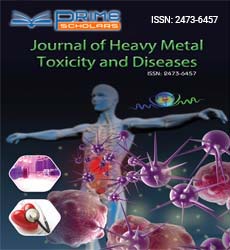Commentary - (2024) Volume 9, Issue 5
Pharmaceutical Interventions: Targeting Heavy Metal Toxicity with Prescription Medications
Zhang Zhu*
Department of Pharmaceutics, Hong Kong University, China
*Correspondence:
Zhang Zhu,
Department of Pharmaceutics, Hong Kong University,
China,
Email:
Received: 01-Oct-2024, Manuscript No. ipjhmct-24-21861;
Editor assigned: 03-Oct-2024, Pre QC No. ipjhmct-24-21861 (PQ);
Reviewed: 17-Oct-2024, QC No. ipjhmct-24-21861;
Revised: 22-Oct-2024, Manuscript No. ipjhmct-24-21861 (R);
Published:
29-Oct-2024, DOI: 10.21767/2473-6457.24.5.48
Description
Heavy metal toxicity is a significant public health concern, arising
from exposure to metals such as lead, mercury, arsenic, and
copper. These metals can accumulate in the body over time,
leading to severe health issues affecting the nervous system,
kidneys, and other vital organs. While prevention of exposure
is crucial, pharmaceutical interventions play an essential role
in treating established toxicity. This article examines specific
prescription medications used to address various types of heavy
metal toxicity, with a focus on their mechanisms, effectiveness,
and potential side effects. Heavy metals are elements that
have a high atomic weight and density, and they can be toxic
at relatively low concentrations. Common sources of exposure
include contaminated water, industrial emissions, dietary intake
and occupational hazards. Symptoms of heavy metal toxicity
can vary widely depending on the metal involved and the
level of exposure, but they often include neurological deficits,
gastrointestinal. Pharmaceutical interventions for heavy metal
toxicity typically involve the use of chelating agents substances
that bind to heavy metals in the body, facilitating their excretion.
Here are some key medications used for specific types of heavy
metal toxicity: Penicillamine is a chelating agent primarily
used to treat Wilson’s disease, a genetic disorder that leads to
excessive copper accumulation in the body. This condition can
cause liver damage, neurological symptoms, and psychiatric
disorders. Penicillamine works by binding to copper ions,
forming a complex that can be excreted through the kidneys.
This reduces copper levels in the liver and other tissues. Clinical
studies have shown that penicillamine effectively lowers copper
levels and alleviates symptoms in patients with Wilson’s disease.
Common side effects of penicillamine include gastrointestinal
upset, skin rashes, and, in rare cases, more severe effects like
kidney damage or bone marrow suppression. Regular monitoring
of liver function and blood counts is recommended during
treatment. Dimercaprol binds to heavy metals, facilitating their
excretion via the kidneys. It is particularly effective in cases of
acute exposure and can be administered intramuscularly. Studies
indicate that dimercaprol can significantly reduce levels of
arsenic and mercury in the body, leading to clinical improvement
in poisoned individuals. Side effects may include hypertension,
tachycardia, and allergic reactions. Its use can also lead to the
redistribution of some metals, necessitating careful monitoring.
Ethylenediamine tetraacetic acid is commonly used in the
treatment of lead poisoning. Lead exposure can occur through
various sources, including lead-based paints, contaminated
water, and occupational hazards. Ethylenediamine tetraacetic
acid works by chelating lead ions in the bloodstream, which are
then excreted through the urine. It effectively reduces blood
lead levels and alleviates associated symptoms. Ethylenediamine
tetraacetic acid therapy has been shown to decrease lead levels
and improve neurological outcomes in children and adults
with lead toxicity. Potential side effects include renal toxicity,
hypocalcaemia, and allergic reactions. Deferoxamine binds
free iron in the bloodstream, preventing it from contributing to
oxidative stress and tissue damage. The iron-chelate complex is
then excreted via the kidneys. Clinical studies demonstrate that
deferoxamine effectively reduces iron levels, thereby decreasing
the risk of organ damage and improving patient outcomes. Side
effects may include hearing loss, vision changes, and allergic
reactions. Patients often require monitoring for these potential
complications. Pharmaceutical interventions play a critical role
in the management of heavy metal toxicity, providing targeted
treatment to mitigate the effects of these harmful substances.
While these treatments can be lifesaving, they are not without
risks. Potential side effects necessitate careful monitoring and
management by healthcare professionals.
Acknowledgement
None.
Conflict Of Interest
The author states there is no conflict of interest.
Citation: Zhu Z (2024) Pharmaceutical Interventions: Targeting Heavy Metal Toxicity with Prescription Medications. J Heavy Met Toxicity Dis. 09:48.
Copyright: © 2024 Zhu Z. This is an open-access article distributed under the terms of the Creative Commons Attribution License, which permits unrestricted use, distribution, and reproduction in any medium, provided the original author and source are credited.

